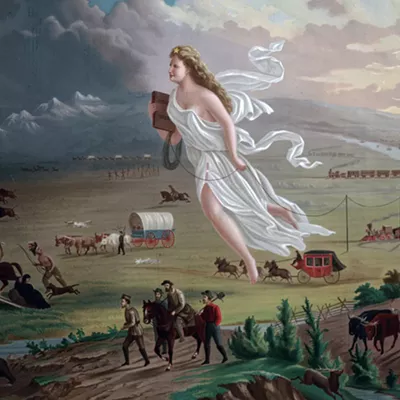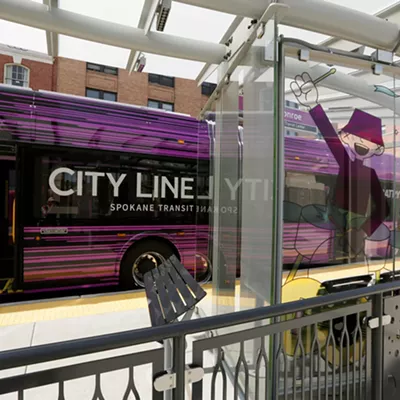Everybody has an opinion on the Spokane Transit Authority. The buses are too big. They run too frequently, and there's never anybody on them. They never run when I need them. Why do they go there and not down my street? What did we ever need the bus plaza for?
No one ever said providing public transportation in a world dominated by the single-occupant vehicle would be easy, and over the last couple of years it's gotten increasingly difficult right here in Spokane. The STA has been under fire for overspending first on the new plaza and lately on administration. So it's a tough sell to get more money, which they will try to do on Sept. 17, when voters within its service area will decide whether to approve a sales tax increase of up to three-tenths of one percent -- enough to continue to fund the bus system as we know it.
That's three pennies on every $10 taxable purchase -- a number that happens to be equal to what the STA is already collecting via the sales tax.
A full increase would net STA about $17 million a year -- for an infinite number of years. Sounds like a sweet deal? Well, not according to STA administrators.
"This is almost exactly the same amount as we lost through the adjustment of the motor vehicle excise tax [I-695]," says Susan Millbank, who works for STA's policy and government relations office.
So what exactly would bus riders in Spokane get for $17 million? Would they get an expanded system? Or perhaps great new buses? It doesn't look that way -- at least not right away.
"If this proposition passes, what we would do is to undertake a completely public process to determine what additional services would look like," says Robert Allen Schweim, executive director of STA. "We've already had some informational meetings, and people have asked for increased express services, that runs not only on I-90, or for service more often, or earlier in the morning or later at night. We have a large medical community in town, and many people in that system work overnight or at late shifts."
Currently, the STA gives about 8.5 million rides per year. That's close to 17 trips per person living in Spokane County. The actual fare collected covers just a fraction of the actual cost of running the system.
"Approximately 25 percent of our costs are covered by the fare. Before our fare increase [in February of this year], that was 21 percent," says Schweim. "The paratransit we do only recovers about 2.5 percent, but there isn't much we can do about that. State and federal regulations require that we provide that service, and it's very important to many people, but it's still an unfunded mandate."
The STA can't campaign for the proposition, but the group Citizens for Public Transportation has done a pretty good job putting up signs in the area.
So far, the group has raised more than $25,000, and its three largest contributors are, perhaps not surprisingly, unions.
The Amalgamated Transit Union's national office in Washington, D.C., has given $5,000. So has the Amalgamated Transit Union's Spokane group, local 1015. And from the Amalgamated Transit Legislative Council in Tacoma came $3,000. Clearly, there are union jobs on the line here.
But CPT also has plenty of smaller, local supporters, in the $10 to $500 category.
"When we had our kickoff event, there was an anonymous person who put $10 in an envelope specifically for pins," says Mike Brewer, former city council member and treasurer for CPT. Brewer used to serve on the city's transportation board and says that a small increase in sales tax -- that basically won't hurt the very needy, as he puts it, because it doesn't apply to food and medicine -- is the only way to go.
"It's a little like financing your house. People don't often think about that, but if you finance everything you need, you end up paying double for the house, compared to if you had the cash in your hand," says Brewer. "This would allow the STA to go back to more frequent service. By passing Proposition 1, the STA would be able to continue to operate on its own money, we wouldn't have to go out and finance all the stuff they need to keep running."
One of the STA's most persistent and loudest critics is Dave Hamer, whose men's clothing store used to be downtown, across from the bus plaza.
"I don't care how they are trying to explain this, they have too many buses, too many drivers and too many routes," says Hamer, who is part of a very loosely organized grassroots organization, Citizens for Responsible Transit, which has yet to raise any money.
"I'm not opposed to public transit. People say I never rode the bus -- that's not true, I rode the bus for years," says Hamer. "They require too much overhead to run the system. They saw this coming, they knew they were going to have to cut services and they didn't. They act like a federal agency, you know, they have to spend all their money before they can ask for more."
Hamer especially doesn't trust the management of STA.
"If this proposition passes, it won't change anything. It will still be the same people in charge of the organization, running things the same way," he says. "I hope the public becomes more rational about how the STA is managed. They are spending our money, and it's foolish the way they are spending it now."
Hamer has long campaigned against the bus plaza, and he maintains it would be much better to move the big diesel buses out to the train station, and have smaller buses run downtown and on the lower South Hill.
Regardless of who is to blame, the fact is that the STA has eaten its way through most of its reserves. Earlier this year, STA Director of Planning and Finance James L. Plaster said that coming out of 2001, the authority's reserves were at $32 million. In 2002, another $14 million will be drawn from the account and put towards the daily costs of running the system. By the end of 2003, Plaster predicted, STA would be forced to undertake some precipitous action if new funding sources hadn't been found by then.
Schweim says some of the potential new funding would go toward the increasingly meager savings account.
"But this is not just to amass reserves," he says. "There is an incomplete discussion currently with the board as to what exactly the appropriate level of reserves is. That all ties into the revenue stream and the amount of expenses we are accruing."
There's only one thing that's certain at this point, it seems. If Proposition 1 doesn't pass, we'll see cuts in services.
"If it doesn't pass, we'd have to do at least a 40 percent reduction system-wide," says Millbank. "It's difficult to make these cuts in paratransit -- that is a service we must provide -- so it's hard to be more specific, but there's definitely going to be a reduction of services."
Schweim seconds that warning.
"We would have to look at reducing our expenses and bring them in line with our revenue -- we couldn't spend any more than we make," he says.
But wait. To some people, that sounds like a good plan.
"The existing system could simply not continue," he continues. "People always say we should cut the service on weekends and holidays, but that would only give us a 17 percent cut -- that isn't even half of what we'd need to cut."
Before people embrace the notion that the system should pay its way like a business, it's worth mentioning that no bus system in the nation breaks even. It's a subsidized public service people get for paying their taxes.
"The bus service can't run on bare revenue," says Millbank. "That's why it's part of the government's infrastructure, like roads."
Ultimately, the success of any public transportation system comes down to how much people are willing to pay for it -- even those who don't ever set foot on a bus.
"That's the decision voters will have to make at the ballot," says Schweim. "Which services would I like to have available to me, and how much am I willing to pay for them?"















